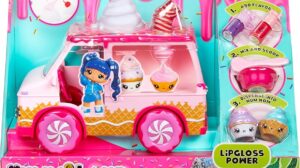It’s hard to believe that this summer our Cali Doodles will be 3 years old! In the same breath, it feels like a lifetime ago that we brought home our 8 week old Multigen Australian Labradoodle and became a family of 6 in 2013! Back then, I knew having a puppy was like having a brand new baby (Oh the sleepless nights! Oh the potty training!) but I didn’t fully understand how much our dog would really become part of our family until much later.
 Birthday parties involve Cali, holidays definitely involve our Cali, and vacation and travel involve our Cali as well (approximately 30% of Canadians bring their pets on vacation, with 43% of dog owners always taking their dog along). Sometimes she travels with us when we visit family (sometimes as far as 8 hours away), she’s even had a flight this past winter, and sometimes she visits her favorite kennel here in Regina and plays with her friends. We like to travel with her when we can, as it saves us money of course, but she also enriches the experiences when the whole family is together (I truly feel it helps keep the kids grounded having Cali with us).
Birthday parties involve Cali, holidays definitely involve our Cali, and vacation and travel involve our Cali as well (approximately 30% of Canadians bring their pets on vacation, with 43% of dog owners always taking their dog along). Sometimes she travels with us when we visit family (sometimes as far as 8 hours away), she’s even had a flight this past winter, and sometimes she visits her favorite kennel here in Regina and plays with her friends. We like to travel with her when we can, as it saves us money of course, but she also enriches the experiences when the whole family is together (I truly feel it helps keep the kids grounded having Cali with us).
Keeping Cali hydrated when we travel is important – she gets nervous in the car, and pants like crazy. Just like the kids need stops for potty and a snack, so do pets. When we stop, we ensure Cali gets a drink after all that panting. When we get to our hotel or family’s house, we feed her and give her a big bowl of water as well. It’s a good idea not to feed your pet too much before travel, to avoid stomach upset, so if you can ensure they’re hydrated for travel that helps a ton.
I recently learned about mixed feeding, and it’s benefits not only to help dogs stay healthy and maintain a healthy body weight, but also how it can help with hydration. With summer travel, and hot weather, ahead, I thought this was worth looking into.
Around 44% of pet owners feed their pet wet food on a regular basis, and one quarter (25%) said they never serve their pet wet food. Until recently I was among that 25%. We had some assumptions about feeding, like thinking that dry food was ‘enough’ for our dog’s diet, and also I really thought Cali would gobble up wet food and over-indulge and gain a ton of doggie-weight. I also had no clue that wet food could help avoid dehydration (duh!).
 While dry food is a concentrated energy source and its crunchy texture helps maintain your pet’s oral health, wet food contains fewer calories than dry food and helps your pet maintain a healthy body weight. Serving your pet wet food will not cause them to gain weight if it’s properly integrated into their diet. If slowly introduced, it will actually cause your pet to ingest fewer calories while also providing them with extra health benefits. It also has numerous health benefits, including reducing urinary tract infections.
While dry food is a concentrated energy source and its crunchy texture helps maintain your pet’s oral health, wet food contains fewer calories than dry food and helps your pet maintain a healthy body weight. Serving your pet wet food will not cause them to gain weight if it’s properly integrated into their diet. If slowly introduced, it will actually cause your pet to ingest fewer calories while also providing them with extra health benefits. It also has numerous health benefits, including reducing urinary tract infections.
Introducing your pet to a mixed feeding diet is easy – start off with a ratio of about 25% new food to 75% old food, and work your way up from there over about a week (you should do this anytime you’re introducing new food into your dog’s diet). Later, you can decide what works best for your mixed feeding regimen – either wet for breakfast and dry for dinner or a combination of both at every meal.
In our case, a combination of both works best. We actually have a odd doggie – often times we can give her her breakfast and find it still waiting there later that afternoon (which is apparently crazy-weird for a lab breed). With our IAMS mixed feeding diet, she loves her food and eats both the wet and dry (much like me when I get started on steak frites, it ain’t over until the plate is empty!) We have just started with the ratio mixture, working up to her new IAMS food 100%, so I’ll post again in a few weeks to update how it’s going!
You can learn more about mixed feeding at www.petmixedfeeding.ca.






so how was her spa day? she get a trim?
I honestly had no idea that mixed feeding was a good thing. I was always told dry food only. Am going to start introducing wet food to my cat to see how he does.
I’ve always been a strong believer in both wet and dry feelings for my dogs
oh my gosh your doggie is such a cutie! that first pic made me smile. Trick or Treat I ate your pumpkins face LOL
I rescued both my cats and have always fed them wet and dry. It’s important for cats to have wet food to avoid urinary tract issues.
We always had to mix feed Butch! We also have to change food, he gets bored and wont eat it. When he was little, I had to mix rice, dry food and soft food or he wouldn’t eat.
we always give our cat wet and dry food!
So far I have been only giving my pooches dry food and lots of healthy human food, I must look into the mixed feeding!!
My two cats eat both wet and dry food. My vet even said to mix an extra spoonful of water into their wet food to make sure they are getting enough. It makes extra gravy so they like it even more!
Cali seems very happy with her family.
Interesting ideas – I need to look into this more!
I never really considered this, but really, why not? They are a part of the family, and should feed them a well balanced diet
We have always just used dry cat food but I see the benefits of mixed feeding.
I like to do mix feeding as its good and it changing things up for them.You have a beautiful dog and im sure a wonderful addition to your family
I am in the 25%, will do some more research into this.
I tried wet food but then my dog didn’t want to eat the dry food. As for your dog and travel can’t you ask a family or friends to care for him while you’re gone. The reason I ask because my husband and I take care of pets when asked by friends and family.
We do mixed feeding with our dogs but not our cats. Thinking we should really start doing it for them too. We have seen the benefits in our dogs.
I usually only feed my cat dry food as well. I’ll have to check it out.
We always fed our siamese cat a mix of wet and dry. Our tabby cat hates wet food. She wont even look at it.. haha
I’m like Andrea – I just thought all we needed was dry food. I’ll go look at some canned stuff too!
SUch a cute pup. Glad we own a pet store so we get to see cute dogs quite frequently
we for the most part have been feeding a mixed diet.
I hadn’t known much about the benefits of mixed feeding before reading your post. Thanks for sharing!
her tilting of the head could melt the coldest of hearts, so cute
Your dog is gorgeous!
Mixed feeding for my doggy is great!